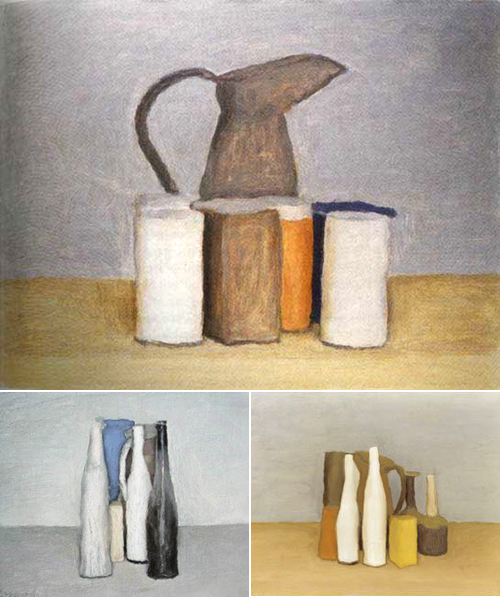|
The
collection
of
the
Genoese
engineer
Alberto
Della
Ragione
represents
an
extraordinarily
comprehensive
overview
of
Italian
Modernism,
spanning
key
movements
and
tendencies
from
Futurism
to
the
Scuola
Metafisica,
Novecento
and
Corrente.
Visitors
to
"From
Morandi
to
Guttuso:
Masterpieces
from
the
Alberto
Della
Ragione
Collection",
on
view
at
the
Estorick
Collection
of
Modern
Italian
Art,
39a
Canonbury
Square,
London
N1,
until
3
April
2011,
will
be
able
to
see
some
40
major
works
by
some
of
Italy’s
most
celebrated
artists
of
the
20th
century,
including
Carlo
Carrà,
Giorgio
de
Chirico,
Filippo
De
Pisis,
Marino
Marini,
Giorgio
Morandi,
Gino
Severini,
Mario
Sironi
and
Emilio
Vedova.

Morandi
(1890
–
1964)
Della
Ragione
began
acquiring
works
of
Modernist
art
towards
the
end
of
the
1920
sand
donated
his
collection
to
the
city
of
Florence
in
1969
as
agesture
of
solidarity
and
affection
following
the
devastating
flood
three
years
earlier.
Last
exhibited
in
2006,
the
works
have
been
in
temporary
storageat
the
city’s
Forte
diBelvedere,
making
this
exhibitiona
rare
opportunity
toexplore
Della
Ragione’s
outstanding
collection
while
a
new
home
is
being
arranged.
Alberto
Della
Ragione
(1892-1973)
was
born
in
Piano
di
Sorrento
but
moved
to
Genoa
at
an
early
age.
He
became
as
killed
naval
engineer
and
developed
an
interest
in
music,
poetry
and
the
visualarts,
initially
collecting
19th
century
painting.
He
then
began
to
engage
with
Modernist
tendencies,
establishing
relationships
with
the
Futurist
painters
Fillia,
Enrico
Prampolini
and
Fortunato
Depero.
By
1934
his
collection
included
fifteen
works
by
Sironi,
twelve
by
Arturo
Tosi,
eight
by
Giorgio
de
Chirico,
ten
by
Filippo
de
Pisis
and
six
sculptures
by
Arturo
Martini.
Later
additions
to
the
collection
were
works
by
Massimo
Campigli
and
Giorgio
Morandi,
amongst
others,
from
Vittorio
Barbaroux’s
Galleria
Milano.
Among
these
were
a
'Self
Portrait
by
Modigliani'
(no
longer
in
the
collection),
on
which
Della
Ragione
spent
the
money
set
aside
for
purchasing
an
apartment,
and
rare
examples
of
Metaphysical
art.
Toward
the
end
of
the
1930s
Della
Ragione
began
to
turn
his
attention
to
the
work
of
the
younger
artistic
generation
which,
due
to
the
difficult
socio-political
conditions
prevailing
within
Italy
under
the
Fascist
dictatorship
of
Benito
Mussolini,
was
greatly
in
need
of
support.
Drawing
up
contracts
with
artists
such
as
Renato
Guttuso,
Renato
Birolli
and
Giuseppe
Santomaso,
Della
Ragione
guaranteed
them
amonthly
stipend
in
exchange
for
first
refusal
topurchase
their
works.
This
approach
distinguished
his
activity
from
that
of
other
contemporary
collectors,
who
instead
focused
on
more
established
names.
In
1942
Della
Ragione
opened
the
Galleria
della
Spiga
e
Corrente,
which
was
forced
to
close
in
1944
due
to
the
deteriorating
conditions
of
war-torn
Italy.
There
after,
Della
Ragione
bought
works
only
sporadically
for
the
remainder
of
his
life.
Like
that
of
Eric
Estorick,
Della
Ragione’s
collection
reflects
strong
personal
tastes
and
is
marked
by a
predilection
for
figurative
art.
It
brings
together
a
number
of
works
representative
of
the
‘return
to
order’,
that
Europe-wide
phenomenon
of
the
inter-war
years
that
saw
artists
eschew
the
iconoclasm
and
fragmente
dimagery
typical
of
the
pre-war
avant-gardes
in
favour
of
more
enduring,
traditional
subject
matter
and
formal
vocabularies.
Italian
artists
responded
to
this
impulse
in a
variety
of
ways.
The
Novecento
movement,
dominated
by
Mario
Sironi,
promoted
an
art
grounded
in a
sobervisual
language
of
solid,
well-defined
forms
influenced
by
indigenous
painterly
traditions.
On
the
other
hand,
he
meditative
still
lifes
of
Giorgio
Morandi,
are
reflective
of
the
tendency’s
stress
on
the
magic
and
poetry
of
ordinary
objects
– an
aspect
of
his
art
that
forms
a
point
of
contact
with
the
work
of
another
painter
represented
in
the
collection,
Giorgio
de
Chirico.
In
1934
the
inventor
of
Pittura
metafisica,
whose
dream
like
landscapes
were
to
exert
a
huge
influence
on
the
development
of
Surrealism,
began
a
series
of
paintings
entitled
'Mysterious
Baths'
inspired
by
Jean
Cocteau’s
'Mythologie',
one
of
which
is
included
in
the
current
exhibition,
revealing
de
Chirico’s
consistent
fascination
with
the
iconography
of
Classical
antiquity.
Severini’s
'Window
with
Pigeons'
may
also
be
considered
an
example
of
this
‘return’
to
figurative
modes
of
expression
between
the
wars.
In
the
pre-war
period
Severini
had
belonged
to
the
Futurist
movement,
which
represented
the
opposite
extreme
of
this
tendency
in
its
insistence
on
the
centrality
of
modern
subject
matterand
sensations.
Della
Ragione’s
interest
in
the
Futurist
movement
forms
another
parallel
with
the
collection
of
Eric
Estorick,
although
where
the
latter’s
interest
was
focused
on
the
movement’searly
works,
Della
Ragione
concentrated
on
its
evolution
during
the
1930s.
Artists
central
to
Futurism
during
these
years
included
Fillia,
Depero
and
Enrico
Prampolini,
who
is
representedby
several
works
reflecting
his
highly
individual
interpretation
of
‘aeropainting’,
agenre
aiming
to
capture
the
‘immense
sensory
drama
of
flight’.
However,
arguably
Della
Ragione’s
greatest
contribution
as a
collector
was
his
support
for
the
artists
of
the
Corrente
movement.
Emerging
in
Milan
in
1938,
it
promoted
an
expressionist-realist
aesthetic
that
was
to
develop
into
the
dominant
tendency
of
the
early
post-war
years,
influencing
not
only
painting
but
also
literatureand
the
cinema.
The
group
stressed
the
importanceof
a
social
purpose
for
their
art,
rejecting
abstraction
as
too
rarefied
and
uncommitted
anidiom,
and
calling
for
an
art
that
took
accountof
contemporary
life.
It also
constituted
an
actof
resistance
against
the
stultifying
cultural
climate
of
the
times
and
the
rhetorical
imagery
favoured
by
the
Fascist
regime.
Della
Ragione
acquired
some
of
the
most
important
works
produced
by
the
group
that
reflect
the
favoure
dexpressionistic
aesthetic
such
as
'Scantily-dressed
Women'
by
Renato
Guttuso
and
'Butchered
Ox'
by
Bruno
Cassinari.
This
outstanding
selection
of
works
from
the
collection
will
provide
the
viewer
with
an
overview
of
the
most
significant
tendencies
in
Italian
art
during
the
early
20th
century
and
will
perfectly
complement
the
gallery’s
own
permanent
collection.
The
exhibition
will
be
accompanied
by
an
illustrated
catalogue
containing
essays
by
Laura
Lucchesi,
Curator
at
the
Civici
Musei
e
Chiese,
Florence,
and
Roberta
Cremoncini,
Director
of
the
Estorick
Collection. |